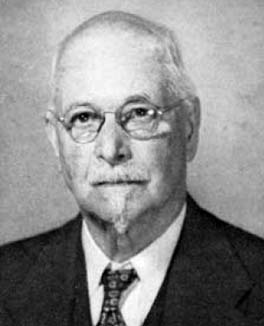
Edwin Bidwell Wilson
 المؤلف:
N T Gridgeman, S Mac Lane
المؤلف:
N T Gridgeman, S Mac Lane
 المصدر:
Biography in Dictionary of Scientific Biography
المصدر:
Biography in Dictionary of Scientific Biography
 الجزء والصفحة:
...
الجزء والصفحة:
...
 1-5-2017
1-5-2017
 826
826
Born: 25 April 1879 in Hartford, Connecticut, USA
Died: 28 December 1964 in Brookline, Massachusetts, USA

Edwin Wilson's father, Edwin Horace Wilson, was a teacher in a secondary school. His mother was Jane Amelia Bidwell. Wilson attended Harvard University, graduating with a A.B. in 1899. He then decided to work for his doctorate at Yale and there he was a student of Gibbs.
Wilson graduated from Yale with a Ph.D. in 1901 and, in the same year, a textbook which he had written on vector analysis was published. Vector analysis (1901) was based on Gibbs' lectures and [1]:-
This beautiful work, published when Wilson was only twenty-two years old, had a profound and lasting influence on the notation for and the use of vector analysis.
Wilson was appointed an Instructor at Yale in 1900 and, after being awarded his doctorate, Wilson went to Paris where he studied at the École Polytechnique, the Sorbonne and the Collège de France during 1902-3. On returning to the United States he continued to teach mathematics as an Instructor at Yale. He became interested in the foundations of geometry, particularly in projective and differential geometry and he published a paper The so-called foundations of geometry in 1903 which criticised Hilbert's approach to geometry.
In 1906 Wilson was appointed as an assistant professor at Yale, then in 1907 he was appointed associate professor at the Massachusetts Institute of Technology. In 1911 he was promoted to full professor. Wilson had been inspired by Gibbs to work on mathematical physics and he began to write papers on mechanics and the theory of relativity. In 1912 Wilson published the first American advanced calculus text [1]:-
... a comprehensive text on advanced calculus that was the first really modern book of its kind in the United States.
Holding a post of professor of physics at the Massachusetts Institute of Technology, he was appointed as Head of the Department of Physics there in 1917. World War I had seen another move in Wilson's research interests for he had undertaken war work which involved aerodynamics and this led him to study the effects of gusts of wind on a plane. In 1920 he published his third major text Aeronautics and gathered round him a group of students working on this topic.
Wilson had already worked in a number of quite distinct areas and his work on aeronautics did not become the major topic for the rest of his career. Not long after the publication of his important text on Aeronautics his interests moved again, this time towards probability and statistics.
He did not study statistics for its own, however, but he was interested in applying statistics both to astronomy and to biology. He was the first to study confidence intervals, later rediscovered by Neyman. In 1922 Wilson left the Massachusetts Institute of Technology to become Professor of Vital Statistics at the Harvard School of Public Health. He continued to hold this post until he retired in 1945, when he became professor emeritus. After he retired, Wilson spent a year in Glasgow, Scotland when he was Stevenson lecture on Citizenship. From 1948 he was a consultant to the Office of Naval Research in Boston.
Gridgeman and Mac Lane in [1] sum up Edwin Wilson's contributions as follows:-
Wilson exhibited a constructively critical mind, quick to expose flaws and errors. Each of his books was an effective and timely exposition of a major subject, and his best papers made lasting impressions. He contributed to many disciplines other than his specialities, including epidemiology, socially, and economics. His greatest originality may have been reached in his papers on statistics - which, interestingly, was a subject he did not explore deeply until middle age.
Wilson received many honours. He was a member of the National Academy of Sciences and he served as vice-president during 1949-53. He was elected a Fellow of the Royal Statistical Society of London, and he was a member of the American Statistical Association, serving as president in 1929. He was also a member of the American Academy of Arts and Sciences, again serving as president during 1927-31. Finally we record his membership of the American Philosophical Society.
- N T Gridgeman, S Mac Lane, Biography in Dictionary of Scientific Biography (New York 1970-1990).
http://www.encyclopedia.com/doc/1G2-2830904682.html
Articles:
- J Hunsaker and S Mac Lane, Edwin Bidwell Wilson, Biographical Memoirs. National Academy of Sciences 43 (1973), 285-320.
 الاكثر قراءة في 1875to1879
الاكثر قراءة في 1875to1879
 اخر الاخبار
اخر الاخبار
اخبار العتبة العباسية المقدسة


